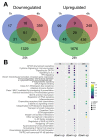Selective Extracellular Signal-Regulated Kinase 1/2 (ERK1/2) Inhibition by the SCH772984 Compound Attenuates In Vitro and In Vivo Inflammatory Responses and Prolongs Survival in Murine Sepsis Models
- PMID: 34638546
- PMCID: PMC8508766
- DOI: 10.3390/ijms221910204
Selective Extracellular Signal-Regulated Kinase 1/2 (ERK1/2) Inhibition by the SCH772984 Compound Attenuates In Vitro and In Vivo Inflammatory Responses and Prolongs Survival in Murine Sepsis Models
Abstract
Sepsis is the leading cause of death in intensive care units worldwide. Current treatments of sepsis are largely supportive and clinical trials using specific pharmacotherapy for sepsis have failed to improve outcomes. Here, we used the lipopolysaccharide (LPS)-stimulated mouse RAW264.7 cell line and AlphaLisa assay for TNFa as a readout to perform a supervised drug repurposing screen for sepsis treatment with compounds targeting epigenetic enzymes, including kinases. We identified the SCH772984 compound, an extracellular signal-regulated kinase (ERK) 1/2 inhibitor, as an effective blocker of TNFa production in vitro. RNA-Seq of the SCH772984-treated RAW264.7 cells at 1, 4, and 24 h time points of LPS challenge followed by functional annotation of differentially expressed genes highlighted the suppression of cellular pathways related to the immune system. SCH772984 treatment improved survival in the LPS-induced lethal endotoxemia and cecal ligation and puncture (CLP) mouse models of sepsis, and reduced plasma levels of Ccl2/Mcp1. Functional analyses of RNA-seq datasets for kidney, lung, liver, and heart tissues from SCH772984-treated animals collected at 6 h and 12 h post-CLP revealed a significant downregulation of pathways related to the immune response and platelets activation but upregulation of the extracellular matrix organization and retinoic acid signaling pathways. Thus, this study defined transcriptome signatures of SCH772984 action in vitro and in vivo, an agent that has the potential to improve sepsis outcome.
Keywords: ERK1/2; SCH772984; cecal ligation and puncture; drugs repurposing; sepsis.
Conflict of interest statement
The authors declare no conflict of interest. The funders had no role in the design of the study; in the collection, analyses, or interpretation of data; in the writing of the manuscript, or in the decision to publish the results.
Figures




References
-
- Rudd K.E., Johnson S.C., Agesa K.M., Shackelford K.A., Tsoi D., Kievlan D.R., Colombara D.V., Ikuta K.S., Kissoon N., Finfer S., et al. Global, regional, and national sepsis incidence and mortality, 1990–2017: Analysis for the Global Burden of Disease Study. Lancet. 2020;395:200–211. doi: 10.1016/S0140-6736(19)32989-7. - DOI - PMC - PubMed
-
- Singer M., Deutschman C.S., Seymour C.C., Shankar-Hari M., Annane D., Bauer M., Bellomo R., Bernard G.R., Chiche J.-D., Coopersmith C.C.M., et al. The Third International Consensus Definitions for Sepsis and Septic Shock (Sepsis-3) JAMA. 2016;315:801–810. doi: 10.1001/jama.2016.0287. - DOI - PMC - PubMed
MeSH terms
Substances
Grants and funding
LinkOut - more resources
Full Text Sources
Molecular Biology Databases
Miscellaneous

